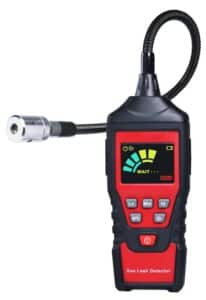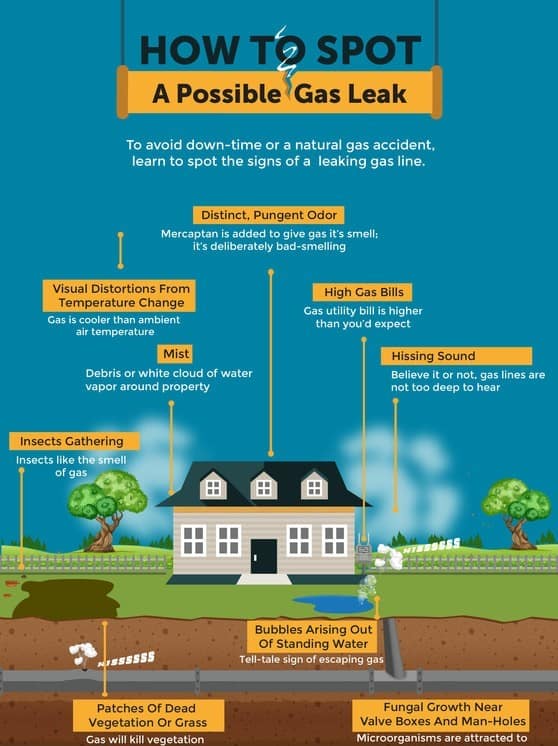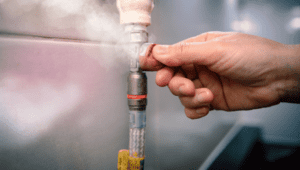Gas Leaks – Leaky Gas: How to Find a Gas Leak in Home – How to Check for Gas Leak
There are 11 ways how to find a gas leak (leaky gas) in home.
When you need to know how to check for gas leak (leaky gas), remember safety comes first.
First, turn off the gas at the gas bottle or meter.
 Open windows and doors, if safe to do so, and then evacuate the building.
Open windows and doors, if safe to do so, and then evacuate the building.
Do not use your phone, light switches or any electrical devices and no open flame when there is a leaky gas (a gas leak in home).
Immediately leave the area and call emergency services (000) from a safe location.
Do not further inspect the gas leak, as LPG is highly flammable and combustible and may lead to a gas leak explosion or fire hazard.
Gas Leaks: How to Test for Gas Leak in Home – Leaky Gas
Here is a summary of eleven ways to test for gas leak (leaky gas) in home:
- Your nose for gas leak detection, as it is you best gas leak sensor, when you detect the gas leak smell of rotten eggs.
- Your ears are another household gas leak detector sensor, when you hear a gas leak (leaky gas) hissing noise.
- An electronic gas leak detector sensor alarm (leaky gas) can be used for household gas leak detection.
- Increased gas bills more than usual are one of the gas leak symptoms of gas leaks (leaky gas).
- Seeing moving dust or a white mist is a visual gas leak detection for leaky gas (a gas leak in home).
- Yellow, orange, or red gas flame colour can be gas leak symptoms for household gas leak detection.
- Scorching or soot in an unusual location on the gas appliance is another visual method of household gas leak detection.
- Gas pilot light keeps going out are another of the gas leak symptoms for gas leaks (leaky gas), with a gas leak in home.
- Dead or dying plants in the kitchen or near the gas appliance are gas leak symptoms.
- Some insects provide household gas leak detection, as they are attracted to leaky gas (a gas leak in home). Think of them as a live gas leak detector sensor.
- Feeling unwell are physical gas leak symptoms (leaky gas) for household gas leak detection.
1. Rotten Egg Gas Leak Smell is Symptomatic of Gas Leaks – Leaky Gas – What Does a Gas Leak Smell Like
What does a gas leak smell like? The gas leak smell is similar to rotten eggs.
For safety reasons, the LPG gas suppliers add an Ethyl Mercaptan odourant to the gas mixture to help how to find a gas leak in home when you use gas leak smell as household gas leak (leaky gas) detection.
 Ethyl Mercaptan is an organosulfur compound that provides a warning odour to LPG gases such as propane, butane, and methane.
Ethyl Mercaptan is an organosulfur compound that provides a warning odour to LPG gases such as propane, butane, and methane.
Natural gas and LPG are naturally colourless and odourless without this additive.
When gas leaks from the cylinder, Ethyl Mercaptan is released with the gas, which you inhale.
For most people, the gas leak smell is like rotten eggs or rotten cabbage when there’s leaky gas (a gas leak in home).
If you notice a foul gas leak smell near any of your gas appliances, check them, if safe to do so, and report the gas leak smell to emergency services (000) immediately.
2. Using Your Ears as a Gas Leak Detector Sensor
Hearing a hissing noise is using your ears for household gas leak detection is how to find a gas leak (leaky gas) as your sensor, as it can be caused by leaky gas (a gas leak in home).
Note that gas leaks only produces hissing noise at higher flow rates, meaning that household gas leak detection by sound is indicative of a lot of gas leaking from the gas leak (leaky gas).
Once again, check for gas leaks (leaky gas) near all of your gas appliances.
Once you determine the general area of the household gas leak, you can utilise the soapy water gas leak test to identify the exact location of the gas leak in home (leaky gas), if safe to do so.
Be sure to check all connections with the soapy water, as well.
However, we do not recommend this once you hear a hissing noise and smell a strong odour of rotten eggs.
Leave the area immediately, turn off any open flames or ignition source, and open all the windows and doors, if safe to do so.
Call emergency services (000) and let them inspect the household gas leak situation further.
3. Electronic Gas Leak Detector Sensor – Gas Leak Sensor
 Another safer way to check for gas leak in home (leaky gas) is using electronic gas leak detector sensor for household gas leak detection.
Another safer way to check for gas leak in home (leaky gas) is using electronic gas leak detector sensor for household gas leak detection.
A gas leak sensor works by allowing gas to diffuse through a membrane and a set of electrode gas leak detector that slightly change current when the gas is chemically oxidised (or reduced).
In other words, when gas leak passes through the electrochemical gas leak detector, it slightly changes the current of the electrodes, tripping the household gas leak detector sensor alarm.
A household gas leak detector sensor can be stationary or a handheld portable.
A gas leak detector sensor has an audio alarm, similar to a smoke detector.
4. Gas Leak Symptoms Can Include Higher Gas Bills from Gas Leaks
If you’ve been keeping track of your gas bills (utility pipes for LNG and frequency of cylinder deliveries for LPG), obvious spikes can be gas leak symptoms and another household gas leak detection method.
Sometimes, gas leaks (leaky gas) may be so small and subtle that household gas leak detection isn’t possible, but the meter doesn’t lie, and gas leaks may show up as increased consumption.
Remember that they use units like cubic meters, cubic feet, kilograms, litres, or gallons and not their monetary value.
Volumetric and mass units are fixed, while prices per cubic metre may vary.
Remember that colder weather, additional gas appliances, or extra house guests can increase or fluctuate gas use without it being a household gas leak..

5. Gas Leak Visual Indicators (Mist or Cloud) for Leaky Gas

Your eyes are another form of gas leak detector sensor, observing a white mist or cloud around your LPG storage or gas appliance for household gas leak detection, it could indicate leaky gas (a gas leak) or pipe rupture.
Swirling dust or particles may also indicate a constantly moving gas from one direction, which is often the source of the gas leak in home (leaky gas).
In these situations, leave the area immediately and call for emergency services (000) from a safe location.
6. Changes in Flame Colour as Gas Leak Symptoms
Changes in flame colour can be leaky gas (a gas leak in home) gas leak symptoms.
A well-maintained gas appliance should produce optimal gas flow and combustion, producing a blue flame.
If you notice red or yellow flame on your burners, it could often mean your appliances need cleaning, or that carbon monoxide is produced due to incomplete combustion.
Otherwise, you may have a gas leak in home (leaky gas).
Gas appliances should be cleaned as needed, once every two years or depending on the manufacturer’s recommendation.
7. Scorching or Soot as a Telltale Sign of a Gas Leak – Leaky Gas
If you see scorching or soot in an unusual locations on the appliance, it may indicate leaky gas when turned on and another household gas leak detection method to find a gas leak.
 For example, a burner connection that has a gas leak in home (leaky gas) may create a flame in an unintended place.
For example, a burner connection that has a gas leak in home (leaky gas) may create a flame in an unintended place.
This is a serious issue as a fire hazard and ignition already exist.
As soon as you notice scorching or soot, stop using the appliance until it is serviced.
8. Pilot Lights That Go Out Can be a Gas Leak Detector Sensor
A pilot light can be a household gas leak detector sensor.
Pilot lights are small flames kept lit in a gas appliance.
They ignite the flowing gas to turn the appliance on and produce heat.
Whilst pilot lights are much rarer in modern gas appliances, they still exist.
Gas leaks (leaky gas) are one cause for a pilot light to keep going out.
An intermittent pilot light becomes a problem because if left unnoticed, leaky gas will keep flowing out of the burner without getting ignited, accumulating in your kitchen or space as a household gas leak.
If the pilot light suddenly lights back up, it may ignite the accumulated gas leak, which could combust and cause massive fires in the kitchen or household or even a gas leak explosion.
If you have that problem, it is time for a service call.
9. Dead or Dying Plants or Trees can be Gas Leak Symptoms – Leaky Gas
Plants are very sensitive to atmospheric changes and suffer when exposed to gas leaks, making their deterioration gas leak symptoms of a gas leak in home (leaky gas) .
If an underground gas leak occurs, caused by corroding pipes or other deterioration, grass, plants or trees nearby may die from suffocation.
House plants can also be affected by leaky gas (a gas leak in home).
If there is no other obvious reason for the tree/plant problem and they are near or on top of a buried gas line, it is worth getting it checked with a gas leak detector sensor as another way to check for gas leak.
Gas leaks (leaky gas) may even affect indoor plants.
If you notice that only those ornamental plants near LPG cylinders and NG lines are wilting, it may be a sign to contact emergency services (000) to have them take a look.
10. Insects are Attracted to Gas Leaks – Leaky Gas – Live Gas Leak Detector Sensor
Some insects are attracted to gas leaks (leaky gas), particularly flies.
They are a living gas leak detector sensor.
If you notices insects swarming around your gas bottles, regulator or gas fittings, it could be an indication of leaky gas (a gas leak in home).
11. Feeling Unwell Due to Possible Carbon Monoxide Poisoning from a Gas Leak
Nausea, headaches, difficulty or irregular breathing, fatigue, chest pain, flu-like symptoms, dizziness or light-headedness, and drowsiness can all be signs of carbon monoxide (CO) poisoning or a gas leak in home (leaky gas). However, using your well being to find a gas leak is not good.
Typically, properly functioning gas appliances are quite safe.
A blue flame is one indication of proper function and complete combustion.
A yellow or red flame can be problematic.
It doesn’t indicate a gas leak but it does indicate an incomplete combustion problem.
As discussed, malfunctioning units may cause incomplete combustion and produce carbon monoxide.
These are caused by clogged gas lines, rusted burner nozzles, an intermittent pilot light, or a gas appliance that needs thorough cleaning.
If you experience any signs of carbon monoxide poisoning while operating your indoor gas appliance, you should stop using it until it is serviced by your gas fitter.
Report Gas Leak: Household Gas Leak in Home – Who to Call for Gas Leak Inside House
If you have a household gas leak in home (gas leak inside house), who do you call to report a gas leak?
There are three typical choices of who to call for gas leak detection (report a gas leak):
- Call your gas fitter to repair a household gas leak in home, especially if it is a gas leak inside the house.
- Call your gas supplier to report a gas leak in home. This is especially the case if the gas leak is outside near the gas bottles, gas fittings or gas meter.
- Call emergency services on 000 (or whatever the number is where you live) for assistance with gas leak detection. This is especially the case if it is a major gas leak that permeates your entire home or if you have no idea where it is coming from outside.
Final Thoughts on Gas Leaks – Leaky Gas
Proper maintenance, observing safety procedures, and using appropriate gas leak in home detection devices can help preserve your property and avoid gas leaks (leaky gas) and fire hazards.
If you notice any subtle signs of leaky gas (a gas leak in home), turn off the gas at the meter or the gas bottle.
Also, if it is safe to do so, leave windows and doors open and then evacuate the building.
Do not operate electrical switches or other ignition sources, including telephones.
As soon as you are in a safe location, call emergency services (000) for assistance.
If there is a fire involved, just evacuate immediately and call for help as soon as possible.
New Residential LPG customer?
New Business LPG customer?
Existing ELGAS customer?
- BBQ – Gas and Charcoal BBQ Features – Charcoal BBQ vs Gas BBQ Comparison - March 31, 2025
- GPL Gas (GPL Fuel) – GLP Gas – LPG Gasul: GLP-GPL Gas Station - March 26, 2025
- Think LPG When Building a New Home - February 26, 2025
Steve Reynolds
Technical Consultant
Steve Reynolds is a leading expert in the LPG industry with over 22 years of experience. As part of the national management team at ELGAS, Steve ensures the safe and efficient storage, handling, and transportation of LPG. He serves as the lead investigator for incidents and collaborates with authorities on industry developments.
Steve is a technical advisor to Standards Australia and Gas Energy Australia (GEA), and an active member of the World LPG Association (WLPGA), contributing to global standards and technical reviews. He holds a BSc. (Hons) in Industrial Chemistry from UNSW and has held senior safety and technical roles at ELGAS, making him a trusted authority in LPG safety and standards.
